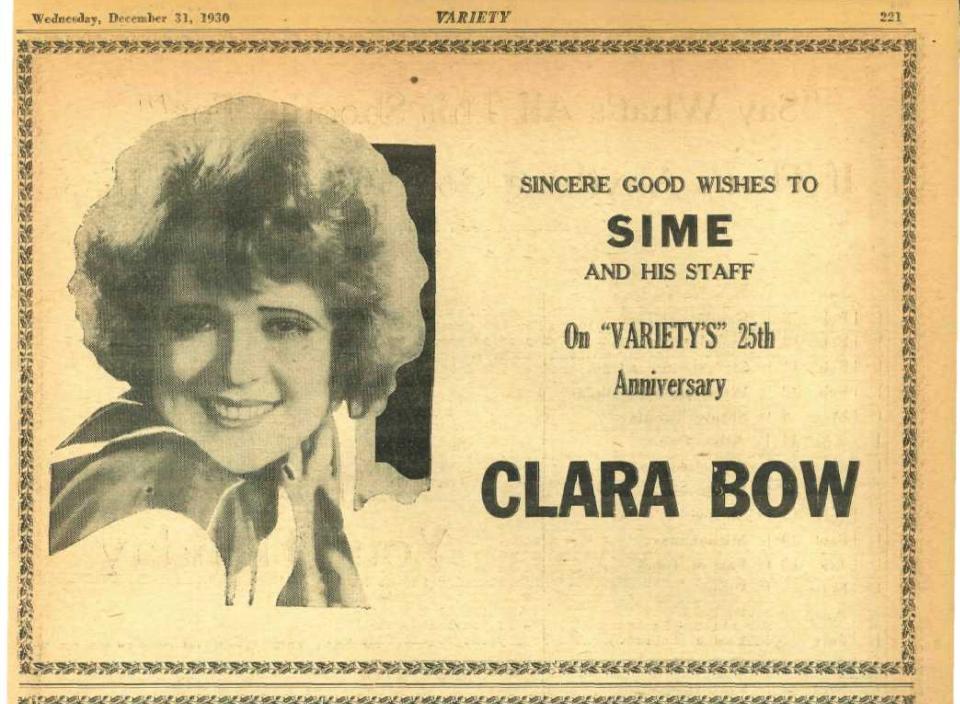Who Was Clara Bow? Taylor Swift Song Sparks Interest in the Rise and Fall of Hollywood’s First ‘It’ Girl

She’s the reason that rising female stars are often called “the It girl.” She starred in the first movie to win an Oscar for best picture. By 1930, she’d made in 45 movies in six years. By 1933, after struggles with men and mental illness, Clara Bow’s Hollywood career was over.
There’s been a surge of interest in the legendary actress who straddled the silent and sound eras this week after Taylor Swift revealed the tracklist for her upcoming album, “The Tortured Poets Department.” The last song on Side D is titled “Clara Bow.”
More from Variety
A native of Brooklyn, Bow grew up in poverty and got her start in pictures after she won a contest sponsored by a magazine. Her prizes were “an evening gown, a trophy and a promise to help the aspiring young actress gain entrée into the film industry,” according to Bow’s biography from Turner Classic Movies. Her big break came with a small part in 1922’s “Beyond the Rainbow.”

Bow kept working for the many independent film companies active in New York at the time. She eventually grabbed the attention of producer B.P. Schulberg, who at the time headed Preferred Pictures. Bow specialized in playing flappers and spunky young women, reflecting the changing attitudes of the roaring 1920s. She began to develop a following with her signature curly bob and bright red lipstick applied in the form of a heart on her upper lip. When Schulberg relocated to Paramount Pictures as a producer, Bow went with him. At Paramount, Bow landed her biggest hit, 1927’s “It,” based on Elinor Glynn’s popular novel about a poor woman who wins the heart of her wealthy employer. “It” turned Bow into a sex symbol, and it also dramatically increased the turmoil in her private life. The same year, Bow starred in the acclaimed drama “Wings,” which nabbed the first best picture win at the inaugual Academy Awards.

Hollywood historians now believe that Bow likely suffered from depression and possibly even bipolar disorder. Her messy private life led to rumors about her behavior and sexual activity, which spurred aggressive attention from the tabloid press. In these years, Bow kept making movies at a breakneck pace, as chronicled in the pages of Variety. She was among the few silent movie stars to make a successful transition to talkies. In 1929 she had a big hit with “The Wild Party,” which drafted off her off-screen reputation.
In the spring of 1931, Bow asked to be released from her Paramount contract and was admitted to a sanatorium, per TCM. Around that time, she met and married actor Rex Bell. After her break, she made two more movies for Fox Studios (prior to its merger with Darryl Zanuck’s 20th Century Pictures). She retired from moviemaking after 1933’s “Hoopla.”

Bow and Bell eventually moved to Bell’s ranch in Nevada. Bow had two children, and she also continued to battle mental health problems. She attempted suicide in 1944, per TCM.
Bell, meanwhile, pursued a career in politics and was elected Nevada’s Lieutenant Governor. After his death in 1962, Bow moved back to Los Angeles. She died of a heart attack in 1965 at the age of 60.
A sad coda to her once-blazing career can be found in the July 9, 1941, edition of weekly Variety, in the form of a three-sentence item at the bottom of page 1 under the headline “Clara Bow’s Short Comeback.” Unfortunately, the report furthered the misperception that Bow’s career was derailed by the advent of sound.
“Clara Bow makes her first film appearance in nine years, soon in ‘Hedda Hopper’s Hollywood’ short,” the item read. “Former ‘It’ girl as been leading a quiet married life in California since retiring shortly after the arrival of talking pictures. Her husband is Rex Bell, former film player.”

Best of Variety
Sign up for Variety’s Newsletter. For the latest news, follow us on Facebook, Twitter, and Instagram.


